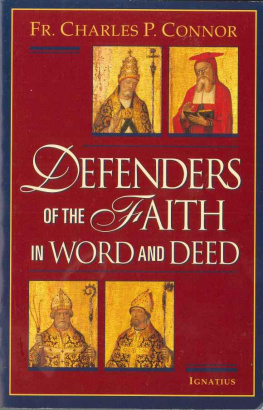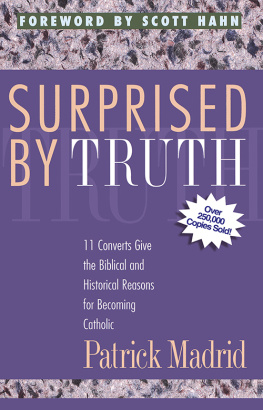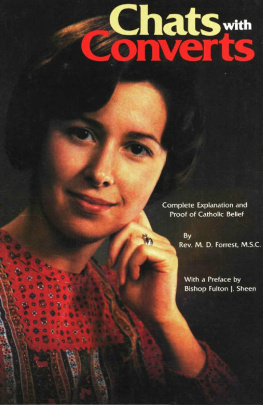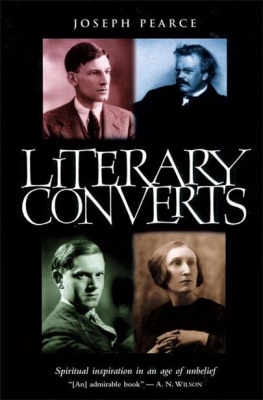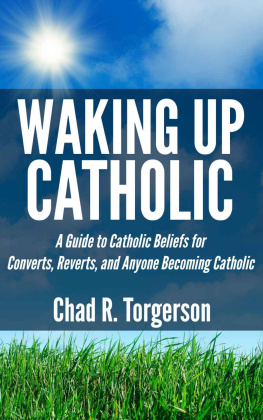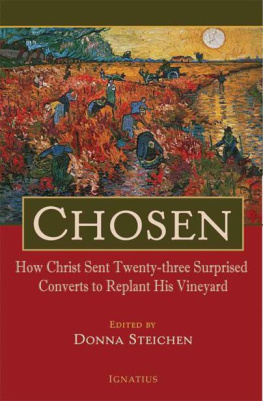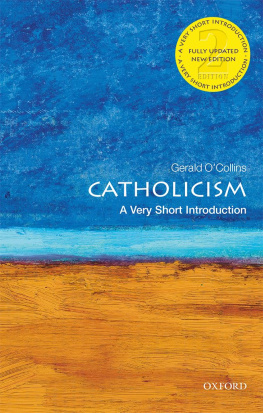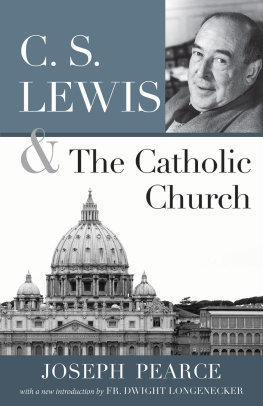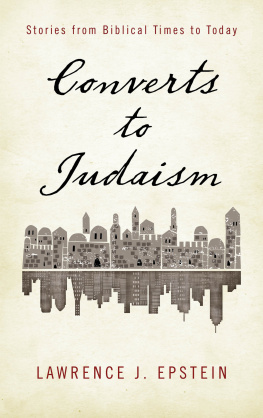Charles P. Connor - Classic Catholic Converts
Here you can read online Charles P. Connor - Classic Catholic Converts full text of the book (entire story) in english for free. Download pdf and epub, get meaning, cover and reviews about this ebook. year: 2001, publisher: Ignatius Press, genre: Religion. Description of the work, (preface) as well as reviews are available. Best literature library LitArk.com created for fans of good reading and offers a wide selection of genres:
Romance novel
Science fiction
Adventure
Detective
Science
History
Home and family
Prose
Art
Politics
Computer
Non-fiction
Religion
Business
Children
Humor
Choose a favorite category and find really read worthwhile books. Enjoy immersion in the world of imagination, feel the emotions of the characters or learn something new for yourself, make an fascinating discovery.
- Book:Classic Catholic Converts
- Author:
- Publisher:Ignatius Press
- Genre:
- Year:2001
- Rating:3 / 5
- Favourites:Add to favourites
- Your mark:
- 60
- 1
- 2
- 3
- 4
- 5
Classic Catholic Converts: summary, description and annotation
We offer to read an annotation, description, summary or preface (depends on what the author of the book "Classic Catholic Converts" wrote himself). If you haven't found the necessary information about the book — write in the comments, we will try to find it.
Fr. Charles Connor writes insightful and wonderfully readable stories of a rich variety of converts who struggled greatly with many challenges as they embraced Catholicism, including rejection by loved ones, persecution from strangers, and misunderstanding by peers. But, once they responded to Gods call, they experienced great inner peace, contentment and joy. Among the famous converts whose stories are told here include John Henry Newman, Edith Stein, Jacques Maritain, Dorothy Day, G.K. Chesterton, Elizabeth Seton, Karl Stern, Ronald Knox and many more.
Classic Catholic Converts — read online for free the complete book (whole text) full work
Below is the text of the book, divided by pages. System saving the place of the last page read, allows you to conveniently read the book "Classic Catholic Converts" online for free, without having to search again every time where you left off. Put a bookmark, and you can go to the page where you finished reading at any time.
Font size:
Interval:
Bookmark:

CLASSIC CATHOLIC CONVERTS
FATHER CHARLES P. CONNOR

IN MEMORY OF MY MOTHER ALICE C. CONNOR WHOSE CATHOLIC FAITH
WOULD INSPIRE ANY CONVERT
THE AUTHOR ACKNOWLEDGES HIS
DEEP GRATITUDE TO
BARBARA QUINN
WHOSE PAINSTAKING WORK FIRST BROUGHT THIS MANUSCRIPT TO LIGHT
CONTENTS
FOREWORD
The Fathers of the Second Vatican Council in their Decree on Ecumenism wrote that "it is evident that the work of preparing and reconciling those individuals who wish for full Catholic communion is of its nature distinct from ecumenical action. But there is no opposition between the two, since both proceed from the marvellous ways of God."Father Charles Connor's Classic Catholic Converts might very well have been titled Marvellous Ways of God as understood by the Council Fathers.Central to the Council's understanding of ecumenism is the Catholic's duty "to make a careful and honest appraisal of whatever needs to be renewed and done in the Catholic household itself, in order that its life may bear witness more clearly and faithfully to the teachings and institutions which have been handed down from Christ through the apostles". Classic Catholic Converts narrates the coming to Catholicism of brilliant intellectuals and religious foundresses, of authors and artists, of political personalities, scientists, and business people. These stories are indeed about individuals finding faith. They are also, however, glorious instances of accomplishing "whatever needs to be renewed and done in the Catholic household itself".The personal influence, teaching, and example of the Catholic men and women who attracted these converts to Catholicism, as well as the lives of the converted themselves, shine forth as both an appraisal and accomplishment of a renewed Catholic household. Marvellous ways of God, indeed. Ecumenism and an individual's full Catholic communion differ, and yet the essential of the former is found in the latter.Walker Percy, author and convert to Catholicism, once wrote to a new convert, "Well, welcome. It is a very untidy outfit you're hooking up with." Father Connor's Classic Catholic Converts, so astutely presented here, completes that observation by forcefully reminding us that, when individuals find the Church, a "tidying up" occurs, a renewal in Christ's Body, the primary task in all ecumenical endeavors.
+ Most Reverend John M. Dougherty, D.D., V.G.
Auxiliary Bishop of Scranton
INTRODUCTION
In his Confessions, Saint Augustine of Hippo tells us that a crucial stage in his conversion occurred when he was told of others' paths to the Faith as well as of their lives in the Faith. He writes: "After Simplicianus recounted the life of Victorinus, I was on fire to follow his examplewhich is why he had told me the story.""Conversion" is a particularly arduous subject on which to write. The author is charged with no small task, because he must record things unutterable: the stirring of souls by the Holy Spirit. To write aptly of conversion, an author must do three things simultaneously. First, he must introduce a character searching for the truth. Second, he must explain how the truth became evident and induced conversion. And third, he must illustrate the effects of conversion. Father Charles Connor succeeds on all three levels.In this cogent and concise volume, Father Connor depicts a plethora of men and women who searched for the truth, found it, and, as the saying goes, "lived happily ever after", that is, happily ever after in striving to follow the Lord Jesus Christ. Though each story of conversion may share these common elements, Father Connor's book is quick to show that no two stories are quite alike. To be sure, each of the conversions recounted herein is uniqueunique in the prior disposition of each soul, unique in the effects of grace upon each soul.Whom do we meet in Father Connor's book? We meet so many converts as to make the book an embarrassment of richesan embarrassment of the riches of God's grace. Let me make mention of but two of the multitude of converts to whom Father Connor introduces us: Edith Stein and Dorothy Day. Contemporaries on either side of the Atlantic, these two women illustrate not only the different backgrounds, cultures, and journeys of so many converts but also the singular effect of the power of the Holy Spirit upon individual persons in their striving to live out fruitfully their transformation in the Faith.Edith Stein came to the Faith from the academy in Germany. After a brilliant university career under the tutelage of the renowned philosopher Edmund Husserl, Edith took the Carmelite habit as Sister Teresa Benedicta of the Cross. The Holy Spirit called her to a life of prayer and sacrifice in the silence and solitude of the cloister. However, the horrors of Nazism wrenched her from her cloister, and her brief earthly life was offered up to God as a holocaust in the fires of Auschwitz.
Dorothy Day came to faith from the slums of America. After a tumultuous and disordered life of protest and political activism, Dorothy founded the Catholic Worker Movement. The Holy Spirit called her to a life of prayer and sacrifice in the hustle and bustle of the street. For the rest of her life, Dorothy was to live as a faithful Catholic in a constant effort to actualize the Church's preferential option for the poor on the streets of New York.
What heart can but be touched by the lives of the like of Edith Stein or Dorothy Day? Father Connor presents their stories, along with so many others, in such ways that we cannot, whether within or outside the Church, be moved. The annals of these many converts enrich each of us. The embarrassment of riches made manifest herein is worthwhile reading for any and all. For those who possess the Faith and for those who seek it, much is to be gained in keeping company with these historic converts. As the Church prays in the first Preface of Holy Men and Women in the Sacramentary, the "great company of witnesses spurs us onto victory, to share their prize of everlasting glory, through Jesus Christ our Lord".
In the following pages, Father Connor takes his lead from Saint Simplicianus, the ancient bishop of Milan and tutor of Saint Ambrose, who illuminated the Faith for the young Augustine through the lives of the saints. Father Connor recounts the conversion of numerous men and women to us. not merely as historical yarns, but as portraits of what we might one day be. He deftly succeeds in fanning the flame of faithwhich is why he tells us these stories.May I conclude this review by thanking Father Michael Hull, professor at Saint Joseph's Seminary, for his invaluable assistance.+ John Cardinal O'Connor
Archbishop of New York
November 23, 1999
ELIZABETH ANN SETON
First American-born saint
Elizabeth Bayley Seton, the first native-born citizen of the United States to be canonized a saint, was of English ancestry and grew up in a family that had settled in colonial New York. Her father, Dr. Richard Bayley, was a physician; her mother, Catherine Charlton, the daughter of an Anglican minister. Together they had three daughters: Mary, Elizabeth, and Catherine. After Catherine's birth, Mrs. Bayley died, and some time later Dr. Bayley married Charlotte Barclay. Though primarily she was English, Charlotte Barclay's mother was also Dutch, a Roosevelt. Hence, through her stepmother, Elizabeth had a connection with both Presidents Roosevelt. She was also the aunt of a future archbishop of Baltimore, James Roosevelt Bayley.Elizabeth was born August 28, 1774, on the eve of the American Revolution. Raised in the Episcopalian faith, she was by all accounts a strikingly beautiful young woman. Trinity Church, Wall Street, very close to the present New York Stock Exchange, was in the late eighteenth century the spiritual nucleus of the city, drawing its social and cultural elite together. Elizabeth knew this fashionable world very well, and when she married William Magee Seton on January 25, 1794, she married into a society to which she was accustomed. She and her husband, a prominent partner in a merchant shipping firm, had a fashionable wedding, and, after living with the Setons for some time, moved into their own home, Number 27 Wall Street. The contrast between Elizabeth's and William's attitude toward religion is interesting:She was earnest, sincere, only just sacramental, a Bible reader with a marked evangelical streak. Her husband, not very religious... belonged to a new breed of men. Today we would label him as an executive. For him trade came first.She, then, was the religious one. There does not appear to be any time in her life when Elizabeth lacked devotion, but in her married adult years her spiritual formation was greatly developed by a twenty-five-year-old High-Church curate serving at Trinity, John Henry Hobart, a scholarly man whose dynamic preaching bespoke conviction and deep spirituality. Hobart was the youngest of three associate ministers assisting Benjamin Moore, the rector of Trinity Church.Hobart was described by one biographer as a man who "was short, disproportioned and wore thick spectacles".He had met John Henry Newman in England, and the convert cardinal had been impressed with his intelligence. Elizabeth Seton and her sister-in-law Rebecca were two parishioners at Trinity who particularly came under his spell. In Elizabeth's case, Hobart had a complex personality to deal with:Betty had amassed an amazing hodgepodge of belief and observance. Thus she wore a Catholic crucifix, looked kindly on the life of the cloister, subscribed to the doctrine of angels, liked Methodist hymns, the quietism of the Quakers and the emotionalism of Rousseau, read general Protestant works, practiced meditation, was inclined to the narrow Calvinism of her ancestors in the matter of sin and punishment, and attended the Episcopal Church.Despite her complexity, or perhaps because of it, the two had an almost immediate spiritual attraction. Elizabeth Seton was in love with God, and Henry Hobart was the man charged in God's providence with bringing this love to a higher earthly potential.Not surprisingly, John Henry Hobart and his wife (who was the daughter of the minister who had officiated at the wedding of Elizabeth's parents) were frequent visitors at the home of the Setons.A letter Elizabeth wrote to a friend, Julia Scott (delivered by Hobart himself), gives us an even better glimpse of what Elizabeth thought of Hobart:The bearer of this letter possesses in full the reality of the last description in my heart.... The soother and comforter of the troubled soul is a kind of friend not often met with. The convincing, pious and singular turn of mind and argument possessed by this most amiable being has made himwithout even having the least consciousness that he is sothe friend most my friend in this world, and one of those who, after my Adored Creator, I expect to receive the largest share of happiness from in the next.Some time later, because of the financial reversals of William Seton, the family moved from Wall Street to Number 8 State Street, a house at the geographical tip of ManhattanIsland, with panoramic views of the river and the bay. Long Island was to the east, New Jersey to the west, and Staten Island to the south. (Today, Our Lady of the Rosary shrine church is located here.)In 1802, William Seton's health began to fail, and he was encouraged to go to a climate more conducive to his recovery. Leghorn (Livorno), Italy, was chosen because, among other reasons, it was the home of the Filicchi family, old friends and business associates of William Seton. Filippo was the head of the Filicchi firm. His wife, Mary Cowper, was from Boston, and through marriage and the prestige of his own business firm, he had become very well acquainted with the United States. He was on friendly terms with such patriots as Washington, Jefferson, and Madison, and he also knew John Carroll of Baltimore, the nation's first Catholic bishop. As proof of the esteem in which he was held, Filippo served as United States consul at Leghorn, most unusual for a native Italian. Filippo's brother, Antonio, was also a partner in the firm. His beautiful and charming wife, Amabilia, was to become very close to Elizabeth Seton.The Filicchis were devout Catholics, though it is not known if in religious matters they ever made any impression on William Seton. William died in Italy in December 1803, and he is buried in the Protestant cemetery in Leghorn.When the grace of Elizabeth's conversion began to crystallize is not clear. It is almost certain, though, that it began while she lived in Italy; there is nothing to indicate any strong attraction to the Catholic Church before, while she was still in New York.We do know that while in Italy she would go frequently with the Filicchis to the Shrine of Our Lady of Montenaro in Leghorn. We also know that on a trip to Florence, she went to visit the cathedral (the Duomo), the Church of San Lorenzo,Santa Maria Novella, and the Medici Chapel and that she was absolutely fascinated with their beauty. Some time later she wrote to a friend:How happy would we be, if we believed what these dear souls believe: that they possess God in the Sacrament, and that He remains in their churches and is carried to them when they are sick! O, my!... how happy would I be, even so far away from all so dear, if I could find You in the church as they do... how many things I would say to You of the sorrows of my of my heart and the sins of my life!Her praying so intently to God that she might find Him seems strongly indicative that she wanted to believe in the Catholic doctrine of the Real Presence.Elizabeth began to confide in her friends the Filicchis, and they provided her with books, all of which she read thoroughly. We know that she read Francis de Sales' Introduction to the Devout Life, a polemical work called The Unerring Authority of the Catholic Church, Bossuet's Exposition of Catholic Doctrine, and an orderly, step-by-step development of the Church's history, compiled and handwritten by Filippo with help from a priest friend, Father Pecci.Elizabeth returned, finally, to New York City, very strongly leaning toward Catholicism. On the lengthy sea crossing she traveled with Antonio Filicchi. He had given her Butler's Lives of the Saints, which she read voraciously. In addition, they practically made a retreatpraying, fasting, and observing feast days with particular devotion.Her greatest undoing in New York came when she let people know of her interest in Catholicism. Basing their questions most often on their own superficial prejudices, they fired an incessant barrage of hostile queries at her. Elizabeth's former mentor, John Henry Hobart, was no less critical:When I see a person whose sincere and ardent piety I have always thought worthy of imitation in danger of connecting herself with a communion which my sober judgment tells me is a corrupt and sinful communion, I cannot be otherwise than deeply affected.... If it should appear that you have forsaken the religion of your forefathers, not from prejudices of education, not for want of better information, but in opposition to light and knowledge which few have enjoyed, my soul anxiously inquires, what answer will you make to your Almighty Judge?Next pageFont size:
Interval:
Bookmark:
Similar books «Classic Catholic Converts»
Look at similar books to Classic Catholic Converts. We have selected literature similar in name and meaning in the hope of providing readers with more options to find new, interesting, not yet read works.
Discussion, reviews of the book Classic Catholic Converts and just readers' own opinions. Leave your comments, write what you think about the work, its meaning or the main characters. Specify what exactly you liked and what you didn't like, and why you think so.


